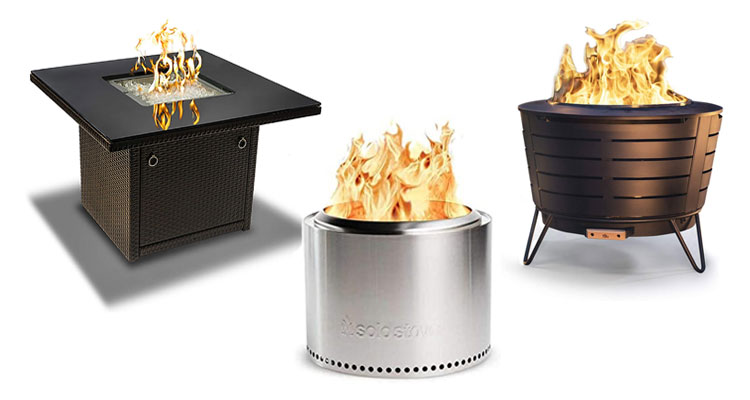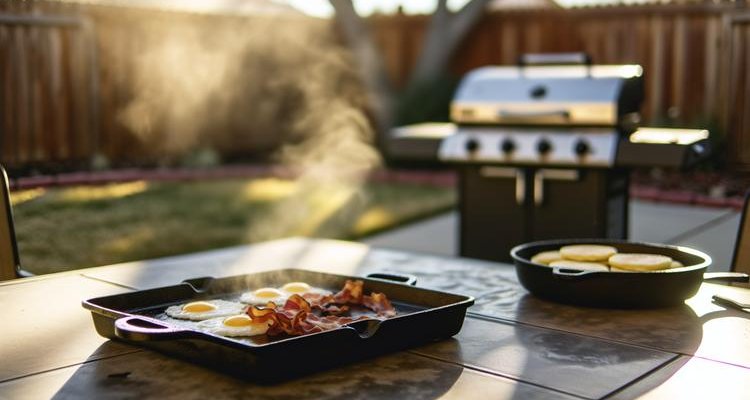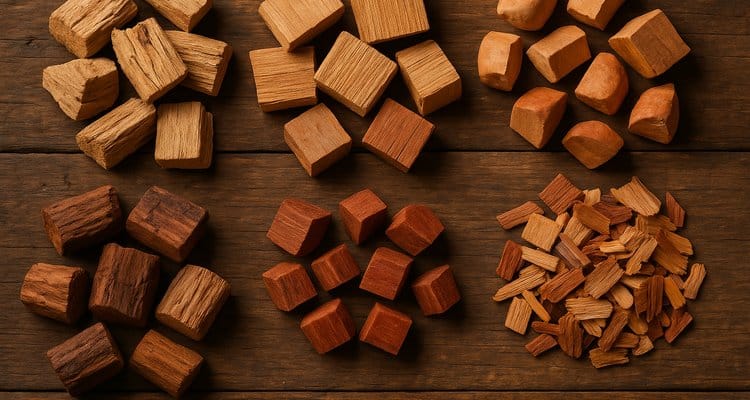
Selecting the right wood for smoking transforms ordinary barbecue into extraordinary culinary experiences. The difference between using generic wood chips and carefully chosen hardwood chunks can mean the distinction between forgettable meals and signature dishes that guests remember for years. Professional pitmasters understand that wood selection affects not just smoke flavor, but also temperature control, burn duration, and even the appearance of your finished barbecue.
The barbecue wood market has evolved significantly, with specialized suppliers now offering kiln-dried, sustainably sourced options that deliver consistent results. Understanding wood characteristics, regional preferences, and proper storage methods ensures you’ll achieve professional-quality smoke every time. This comprehensive guide covers everything from basic wood types to advanced blending techniques, helping you master the art of smoke flavor.
- Wood Fundamentals: Understanding BBQ Wood Basics
- Wood Selection: Choosing the Right Wood
- Regional Styles: Regional BBQ Wood Traditions
- Advanced Techniques: Professional Wood Techniques
- Storage & Safety: Proper Wood Storage
Understanding BBQ Wood Basics
Wood selection forms the foundation of authentic barbecue flavor. Unlike gas or charcoal alone, wood smoke contains over 100 different compounds that create complex flavor profiles unique to each species. These compounds interact with proteins and fats in meat through the Maillard reaction and smoke ring formation, creating both taste and visual appeal.
Wood Forms and Their Applications
Chunks (3-5 inches): Ideal for long smoking sessions in offset smokers and kamado grills. Chunks burn slowly, providing steady smoke for 2-4 hours without constant replenishment. Professional pitmasters prefer chunks for brisket, pork shoulders, and other lengthy cooks.
Chips (1/4-1 inch): Best suited for gas grills and electric smokers where quick smoke generation matters. Chips ignite rapidly but burn out within 20-30 minutes, requiring frequent additions. Soaking chips delays combustion but creates steam rather than enhancing smoke quality.
Pellets (compressed sawdust): Designed specifically for pellet grills, these uniform cylinders provide automated, consistent smoke. Premium pellets contain no fillers or binding agents, using only the wood’s natural lignin for compression. Learn more about choosing the best wood pellets for smoking.
Logs (6+ inches): Reserved for large offset smokers and traditional pit barbecue. Logs require experienced fire management but produce the most authentic smoke flavor. Split logs burn more efficiently than rounds.
Dust (fine powder): Used primarily in cold smoking applications and commercial smokehouses. Dust smolders at low temperatures, perfect for cheese, salmon, and cured meats.
Moisture Content and Seasoning
Properly seasoned wood contains 15-20% moisture content, achieving optimal combustion temperature and smoke production. Fresh-cut “green” wood creates bitter, acrid smoke due to incomplete combustion and excess moisture. Seasoning requires 6-12 months of proper storage, though kiln-dried options provide immediate usability.
Testing moisture content ensures consistent results. Digital moisture meters provide accurate readings, though experienced pitmasters recognize properly seasoned wood by weight, sound when struck, and bark separation. Over-dried wood below 10% moisture burns too hot and fast, producing minimal smoke.
Hardwood vs. Softwood Distinctions
Hardwoods from deciduous trees provide the clean, flavorful smoke essential for barbecue. Their dense cellular structure burns slowly and evenly, producing thin blue smoke ideal for meat. Common barbecue hardwoods include oak, hickory, maple, and fruit woods.
Softwoods from coniferous trees contain high resin levels that create harsh, bitter smoke unsuitable for food. Pine, cedar, fir, and spruce should never be used for smoking meat. The exception involves cedar planks for salmon, where indirect heat prevents resin combustion.
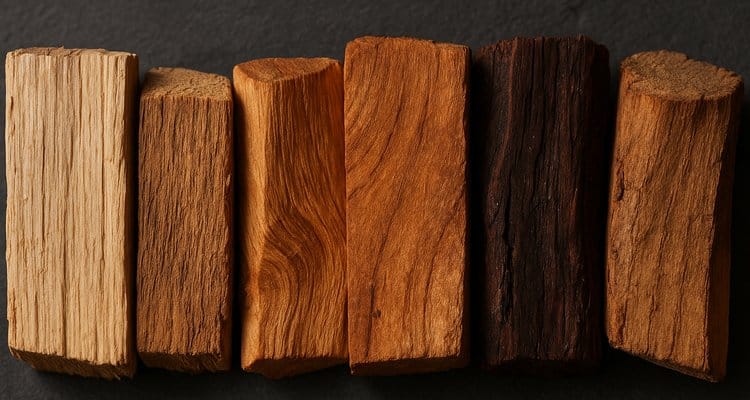
Choosing the Right Wood for Your BBQ
Selecting appropriate wood requires understanding flavor profiles, intensity levels, and meat pairings. Each wood species imparts distinct characteristics ranging from mild sweetness to bold, bacon-like smokiness. Mastering these profiles allows customization for specific dishes and personal preferences.
Mild Woods for Delicate Proteins
Apple: Delivers subtle fruity sweetness perfect for pork and poultry. Apple’s mild profile won’t overpower delicate flavors, making it ideal for beginners. Combines well with cherry for enhanced color.
Alder: Traditional Pacific Northwest choice for salmon and seafood. Provides delicate smoke that complements rather than masks natural flavors. Works excellently with vegetables and cheese.
Maple: Offers mild sweetness similar to apple but with slightly more intensity. Particularly good with pork and vegetables. Sugar maple provides the best flavor among maple varieties.
Cherry: Provides mild, slightly sweet smoke with excellent color enhancement. Creates deep mahogany bark on ribs and shoulders. Combines well with harder woods for balanced flavor.
Medium-Intensity Woods
Oak: The universal barbecue wood, providing medium smoke intensity with neutral flavor. Red oak offers slightly stronger smoke than white oak. Forms excellent base for wood blends.
Pecan: Delivers rich, nutty sweetness stronger than fruit woods but milder than hickory. Excellent all-purpose wood for beef and pork. Native to Southern barbecue traditions.
Walnut: Provides robust, slightly bitter smoke best used sparingly or in blends. English walnut offers milder flavor than black walnut. Pairs well with beef and game meats.
Bold Woods for Robust Flavors
Hickory: The quintessential barbecue wood, delivering strong, bacon-like smoke. Can become overpowering if used excessively. Best for pork shoulders, ribs, and beef.
Mesquite: Produces intense, earthy smoke characteristic of Texas barbecue. Burns extremely hot, requiring careful management. Best suited for beef and direct grilling.
White Oak: Provides strong but refined smoke without bitterness. Excellent for brisket and large beef cuts. Wine barrel oak adds unique complexity.
Wood and Meat Pairing Guide
| Meat Type | Best Woods | Good Alternatives | Avoid |
|---|---|---|---|
| Beef Brisket | Oak, Hickory | Mesquite, Pecan | Fruit woods (too mild) |
| Pork Ribs | Apple, Cherry, Hickory | Maple, Pecan | Mesquite (overpowering) |
| Chicken | Apple, Cherry, Maple | Pecan, Oak | Heavy hickory, Mesquite |
| Salmon | Alder, Cedar plank | Apple, Maple | Hickory, Mesquite |
| Pork Shoulder | Hickory, Apple | Cherry, Pecan | Mesquite (too intense) |
| Turkey | Cherry, Apple, Pecan | Maple, Oak | Strong hickory |
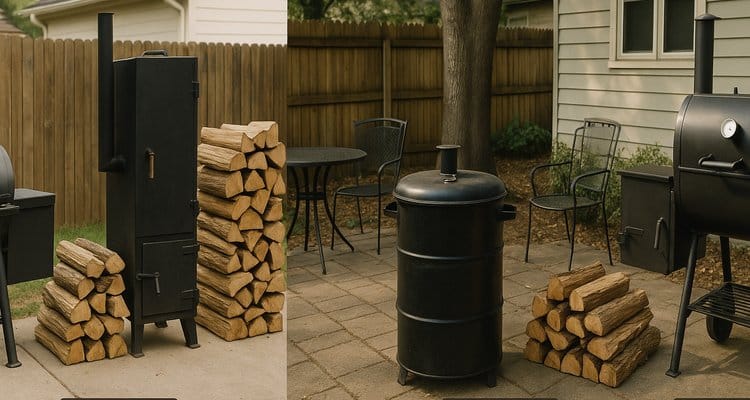
Regional BBQ Wood Traditions
American barbecue traditions developed around locally available wood species, creating distinct regional flavor profiles. Understanding these traditions provides context for wood selection and helps recreate authentic regional styles.
Texas BBQ Wood Preferences
Central Texas barbecue relies heavily on post oak, providing moderate smoke that enhances rather than masks premium beef flavor. The Hill Country tradition emphasizes simplicity – salt, pepper, and oak smoke. Pitmasters maintain consistent 225-250°F temperatures using split oak logs in offset smokers.
South Texas incorporates mesquite for direct grilling and shorter smokes. The intense heat works well for fajitas and barbacoa. West Texas cowboys traditionally used mesquite due to its abundance, developing techniques to manage its intensity.
East Texas shows Southern influence, using hickory and pecan alongside oak. The “low and slow” approach with sauced meats benefits from these stronger smoke profiles.
Carolina Traditions
Eastern North Carolina whole hog barbecue uses primarily oak and hickory, burning down to coals for consistent heat. The mild pork flavor accepts smoke well without becoming overpowering. Traditional pit cooking involves shoveling coals beneath the pig throughout the night.
Western North Carolina (Lexington-style) focuses on pork shoulders with a combination of hickory and oak. The stronger smoke complements the tomato-based sauce characteristic of the region.
South Carolina’s unique mustard-based sauce tradition pairs well with oak and pecan smoke, creating balanced sweet-savory profiles.
Kansas City Style
Kansas City’s “burnt ends” tradition relies on hickory and white oak combination. The sweet, molasses-based sauces stand up to bold smoke flavors. Local pitmasters often blend woods, using fruit woods for color and hickory for flavor.
The region’s competition circuit has refined wood selection to a science, with many teams using precise wood combinations for different meats. Apple-cherry blends for ribs and hickory-oak for brisket represent common choices.
Memphis Methodology
Memphis dry-rub ribs traditionally use hickory and occasionally charcoal for heat with wood chunks for flavor. The moderate smoke allows complex spice rubs to shine. Local pitmasters often add fruit wood during the last hour for color enhancement.
The city’s whole-shoulder tradition uses primarily hickory, though some establishments blend in milder woods to avoid overpowering the meat’s natural flavor.
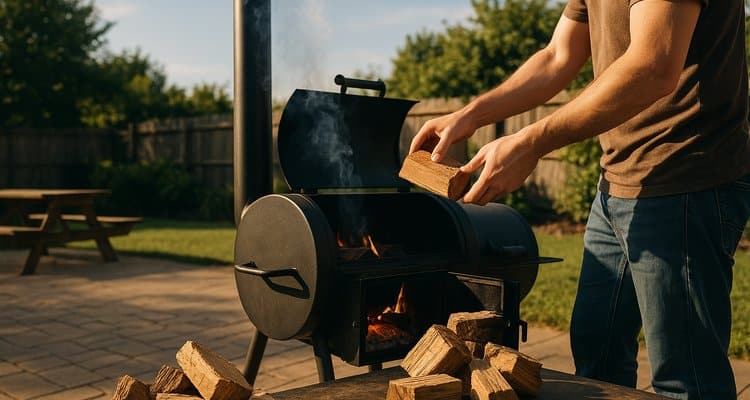
Professional Wood Techniques
Wood Blending Strategies
Professional pitmasters rarely use single wood species, instead creating custom blends for specific flavor profiles. Base woods like oak provide consistent heat and mild smoke, while accent woods add complexity. Common ratios include 70% base wood with 30% flavor wood.
Successful blending requires understanding burn rates and intensity levels. Mixing equal parts hickory and apple balances bold and mild flavors. Adding 20% cherry to any blend enhances bark color without affecting taste significantly.
Time-staged wood addition creates flavor layers. Starting with oak establishes smoke ring formation, adding fruit wood mid-cook provides sweetness, and finishing with pecan adds depth. This technique prevents any single flavor from dominating.
Fire Management Principles
Clean smoke production requires proper combustion temperature between 650-750°F. Thin blue smoke indicates complete combustion, while thick white smoke suggests incomplete burning that creates bitter creosote. Maintaining small, hot fires produces better results than large, smoldering ones.
Preheating wood on the firebox reduces temperature drops when adding fuel. This technique maintains consistent chamber temperature and prevents white smoke production. Many pitmasters keep a rotation system with wood warming zones.
Coal bed management provides temperature stability. Allowing wood to burn down to coals before adding meat creates consistent heat without smoke spikes. Additional wood added to established coal beds burns cleaner than cold starts.
Smoke Ring Development
The prized pink smoke ring forms when nitrogen dioxide in smoke reacts with myoglobin in meat. This reaction only occurs below 140°F internal temperature, making the first hours critical. Wood selection affects ring development, with higher-nitrogen woods like oak and hickory producing better results.
Moisture on meat surface enhances smoke absorption and ring formation. Starting with cold, wet meat maximizes the temperature window for ring development. Some pitmasters spray meat hourly during the first three hours to maintain surface moisture.
Wood moisture content affects nitrogen dioxide production. Slightly higher moisture (20-25%) in the first wood additions can enhance ring formation, though excessive moisture creates other problems.
Temperature Control Through Wood Selection
Different woods burn at varying rates and temperatures, allowing strategic temperature management. Dense woods like oak and hickory maintain steady temperatures, while softer woods like apple burn faster but cooler.
Chunk size affects burn rate more than species. Uniform 3-4 inch chunks provide 2-3 hours of smoke, while mixed sizes create temperature fluctuations. Splitting larger chunks ensures consistent sizing.
Bark removal reduces initial temperature spikes from volatile compounds. While some pitmasters prefer bark for flavor complexity, removing it provides more predictable burns, especially important in smaller smokers.
Proper Wood Storage and Safety
Storage Best Practices
Proper wood storage prevents mold, pest infestation, and moisture problems that ruin smoke quality. Elevated storage off ground contact prevents moisture wicking and improves air circulation. Pallets or purpose-built racks work effectively.
Covered storage protects from rain while allowing airflow for continued seasoning. Avoid airtight containers that trap moisture and promote mold growth. Mesh or slatted covers provide ideal protection.
Rotation systems ensure older wood gets used first. Dating wood purchases and organizing by acquisition helps maintain quality. Most properly stored wood remains usable for 2-3 years, though flavor may diminish over time.
Indoor storage requires proper ventilation to prevent moisture buildup. Basements often prove too humid unless dehumidified. Garages provide better conditions if protected from automotive fumes.
Safety Considerations
Never use treated lumber, painted wood, or manufactured wood products for smoking. Pressure-treated wood contains toxic chemicals that contaminate food. Plywood and particle board adhesives release dangerous compounds when burned.
Moldy wood poses health risks and creates off-flavors. White or green mold indicates moisture problems requiring wood disposal. Black mold presents serious health hazards and requires immediate removal.
Proper wood identification prevents accidentally using toxic species. Learn to recognize poison oak, poison sumac, and oleander, which can cause severe reactions. When uncertain about wood species, don’t use it.
Fire safety requires maintaining clear areas around smokers and storing wood away from heat sources. Keep fire extinguishers accessible and never leave active fires unattended. Dispose of ashes in metal containers after complete cooling.
Purchasing and Quality Assessment
Quality wood suppliers provide consistent, properly seasoned products. Look for vendors specifying moisture content and harvest dates. Reputable suppliers offer single-species woods without mixing.
Inspect wood before purchasing for signs of quality: tight grain, no soft spots, minimal bark separation, and uniform color. Avoid wood with excessive checking (cracks) or insect damage.
Kiln-dried wood offers convenience but costs more than naturally seasoned options. The controlled drying process ensures consistent moisture content and eliminates pests. Competition teams often prefer kiln-dried for predictability.
Bulk purchasing reduces costs but requires proper storage capacity. Buying cords or half-cords provides significant savings over small bags. Split costs with other barbecue enthusiasts if storage space limits quantities.
Common Wood Mistakes to Avoid
Over-Smoking Issues
Excessive smoke creates bitter, acrid flavors that overpower meat’s natural taste. More smoke doesn’t equal better flavor – optimal smoking occurs during the first 3-4 hours when meat temperature remains below 140°F. After reaching this temperature, smoke absorption decreases significantly.
Continuous heavy smoke throughout long cooks accumulates creosote, creating bitter, tar-like deposits. Professional pitmasters often stop adding smoke wood after the first third of cooking time, maintaining heat with charcoal or clean-burning wood.
Signs of over-smoking include dark black bark (instead of deep mahogany), bitter aftertaste, and numbing sensation on the tongue. If guests require sauce to enjoy the meat, over-smoking likely occurred.
Wood Contamination Problems
Chemical contamination from pesticides, herbicides, or fungicides on orchard wood creates health hazards. Only use wood from known sources that hasn’t been chemically treated. Avoid wood from unknown origins or residential tree services.
Automotive contamination occurs when storing wood near vehicles or equipment. Exhaust fumes and oil vapors absorb into wood, creating off-flavors. Maintain separate storage areas for smoking wood.
Pest infestations in stored wood introduce unwanted flavors and potential health risks. Carpenter ants, termites, and wood borers leave waste products that affect smoke quality. Regular inspection and proper storage prevent infestations.
Temperature Management Errors
Using unseasoned wood causes temperature fluctuations as moisture content varies. Wet wood requires extra energy to evaporate moisture before combustion, creating temperature drops and white smoke. Always verify moisture content before use.
Mixing different wood densities without adjustment creates inconsistent temperatures. Adding soft fruit wood to established hickory fire causes temperature spikes. Gradually transition between wood types or maintain separate fires.
Incorrect chunk sizes for smoker capacity leads to temperature control problems. Large offset smokers handle bigger chunks, while smaller cabinet smokers require smaller pieces. Match wood size to your equipment’s capabilities.
Seasonal Wood Considerations
Winter Smoking Adjustments
Cold weather increases wood consumption by 25-40% to maintain temperature. Dense hardwoods like oak and hickory provide better cold-weather performance than softer woods. Pre-warming wood inside before use reduces thermal shock.
Lower ambient temperatures affect smoke flavor development. Smoke condenses more readily on cold meat surfaces, potentially creating stronger smoke flavor. Reduce wood amounts by 20-30% in winter to compensate.
Moisture management becomes critical as snow and ice affect wood storage. Cover wood piles completely and bring next session’s wood indoors 24 hours before use. Ice-covered wood creates temperature instability and excess steam.
Summer Challenges
High humidity affects wood combustion and smoke quality. Humid air contains less oxygen, reducing combustion efficiency. Increase airflow and use slightly smaller wood pieces to maintain clean burns.
Hot weather reduces cooking times, requiring adjusted smoke application. Meat reaches target temperatures faster, shortening smoke absorption windows. Front-load smoke application during cooler morning hours.
Pest activity peaks in summer, requiring vigilant wood storage practices. Inspect wood before each use and avoid storing near standing water where mosquitoes breed. Wood boring beetles become active in temperatures above 70°F.
Transition Season Strategies
Spring and fall temperature swings demand flexible wood selection. Keep variety of wood types available to adjust for daily conditions. Morning cooks may require different wood than afternoon sessions.
Rainfall patterns affect wood moisture and storage needs. Even covered wood absorbs humidity during extended wet periods. Monitor moisture content more frequently during rainy seasons.
Seasonal wood availability varies by region. Apple and cherry pruning occurs in late winter, providing fresh wood requiring seasoning. Plan purchases around seasonal availability for best selection and prices.
Troubleshooting Wood-Related Problems
Identifying Smoke Issues
Thin blue smoke indicates proper combustion and optimal flavor development. This nearly invisible smoke should smell sweet and appetizing. Achieve blue smoke by maintaining small, hot fires with dry wood.
Thick white smoke signals incomplete combustion from low temperature, wet wood, or insufficient oxygen. White smoke creates bitter, creosote flavors. Correct by increasing airflow, raising fire temperature, or using drier wood.
Black smoke indicates burning bark, grease fires, or contaminated wood. Immediately identify and address the source. Black smoke deposits soot and creates acrid flavors requiring meat disposal.
Yellow smoke suggests chemical contamination or treated wood combustion. Never continue cooking with yellow smoke present. Dispose of contaminated wood and thoroughly clean smoker before next use.
Correcting Flavor Problems
Bitter flavors result from creosote buildup, over-smoking, or using green wood. Prevent by maintaining proper combustion temperature and limiting smoke exposure. If bitterness develops, finish cooking without smoke and serve with complementary sauces.
Lack of smoke flavor occurs from insufficient smoke during critical early period, using old wood with diminished oils, or maintaining temperatures too high for smoke absorption. Increase wood amount during first hours and verify wood freshness.
Musty or moldy flavors indicate contaminated wood or poor storage conditions. Immediately stop using suspect wood and inspect storage area. Clean smoker thoroughly before next use.
Harsh, acrid notes suggest using softwood, burning at wrong temperature, or chemical contamination. Review wood source and type, adjust combustion temperature, and ensure proper wood selection.
Equipment-Specific Solutions
Offset smokers require different wood strategies than vertical cabinets or kamado grills. Offset smokers handle larger wood pieces and benefit from log burning techniques. Cabinet smokers need smaller chunks placed strategically for smoke circulation.
Pellet grills have unique considerations regarding smoke production. Supplement pellet smoke with smoke tubes or boxes containing wood chips for enhanced flavor. Quality pellets produce better smoke than economy brands containing fillers.
Electric smokers often struggle with complete combustion due to lower temperatures. Use chips rather than chunks and replace frequently. Consider supplemental smoke generators for improved flavor.
Gas grills require smoke boxes or foil packets for wood addition. Soak chips only for gas grilling to extend smoke production. Position packets over direct heat for best smoke generation. For more tips on getting started with outdoor cooking, check out our complete BBQ beginner’s guide.
Conclusion
Mastering wood selection and usage elevates barbecue from simple cooking to culinary art. Understanding wood characteristics, regional traditions, and proper techniques provides the foundation for creating memorable barbecue experiences. Quality wood, proper storage, and careful fire management produce the thin blue smoke that defines exceptional barbecue.
Remember that wood selection is highly personal – what works for Texas brisket may not suit Carolina pulled pork. Experiment with different combinations to develop your signature flavor profile. Start with proven pairings, then gradually explore blending and advanced techniques as experience grows. For more guidance on smoking a perfect brisket, explore our ultimate guide to brisket.
The investment in quality wood and proper storage pays dividends through consistent results and superior flavor. Whether you’re smoking weekend ribs or competing professionally, wood selection remains fundamental to barbecue success. Take time to source quality wood, store it properly, and master fire management for optimal results. If you’re looking for the right equipment, our guide to the best smoker thermometers can help you monitor your temperatures precisely.
Continue learning through practice, adjusting techniques for your equipment and preferences. The journey toward barbecue mastery requires patience, observation, and willingness to learn from both successes and failures. With proper wood knowledge and technique, you’ll consistently produce barbecue that rivals any commercial establishment.
Contents

